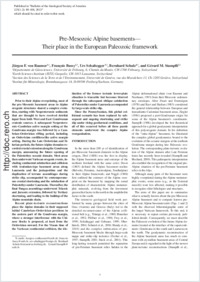Pre-Mesozoic Alpine basements—Their place in the European Paleozoic framework
- Raumer, Jürgen F. von Département de Géosciences, Université de Fribourg, Switzerland
- Bussy, François Earth Sciences Institute (ISTE) Geopolis, Université de Lausanne, Switzerland
- Schaltegger, Urs Section des Sciences de la Terre et de l’Environnement, Université de Genève, Switzerland
- Schulz, Bernhard Institut für Mineralogie, Freiberg/Sachsen, Germany
- Stampfli, Gérard M. Earth Sciences Institute (ISTE) Geopolis, Université de Lausanne, Switzerland
-
31.10.2012
Published in:
- Bulletin of the Geological Society of America. - 2013, vol. 125, no. 1-2, p. 89-108
English
Prior to their Alpine overprinting, most of the pre-Mesozoic basement areas in Alpine orogenic structures shared a complex evolution, starting with Neoproterozoic sediments that are thought to have received detrital input from both West and East Gondwanan cratonic sources. A subsequent Neoproterozoic–Cambrian active margin setting at the Gondwana margin was followed by a Cambrian–Ordovician rifting period, including an Ordovician cordillera-like active margin setting. During the Late Ordovician and Silurian periods, the future Alpine domains recorded crustal extension along the Gondwana margin, announcing the future opening of the Paleotethys oceanic domain. Most areas then underwent Variscan orogenic events, including continental subduction and collisions with Avalonian-type basement areas along Laurussia and the juxtaposition and the duplication of terrane assemblages during strike slip, accompanied by contemporaneous crustal shortening and the subduction of Paleotethys under Laurussia. Thereafter, the final Pangea assemblage underwent Triassic and Jurassic extension, followed by Tertiary shortening, and leading to the buildup of the Alpine mountain chain.Recent plate-tectonic reconstructions place the Alpine domains in their supposed initial Cambrian–Ordovician positions in the eastern part of the Gondwana margin, where a stronger interference with the Chinese blocks is proposed, at least from the Ordovician onward. For the Visean time of the Variscan continental collision, the distinction of the former tectonic lower-plate situation is traceable but becomes blurred through the subsequent oblique subduction of Paleotethys under Laurussia accompanied by large-scale strike slip.Since the Pennsylvanian, this global collisional scenario has been replaced by subsequent and ongoing shortening and strike slip under rising geothermal conditions, and all of this occurred before all these puzzle elements underwent the complex Alpine reorganization.
- Faculty
- Faculté des sciences et de médecine
- Department
- Département de Géosciences
- Language
-
- English
- Classification
- Geology
- License
-
License undefined
- Identifiers
-
- RERO DOC 31873
- DOI 10.1130/B30654.1
- Persistent URL
- https://folia.unifr.ch/unifr/documents/303098
Statistics
Document views: 120
File downloads:
- pdf: 241
